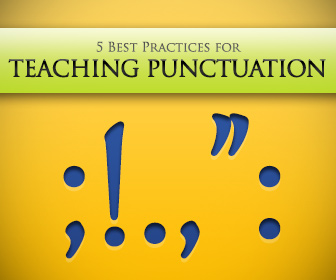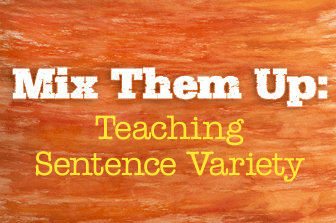How to Teach Punctuation Skills: 5 Best Practices


Students seem to learn one basic pattern of subject, verb, and object and stick to that without fail. Reasons for this vary: students may lack the confidence to stray from this pattern; they may also lack knowledge of the different structures, connecting words, and transitions necessary to create sentence variety. In addition, although lack of sentence variety is certainly not an ESL problem alone, ESL students also lack a native speaker’s intuition about what “sounds right” and may just be unaware in the first place of the monotonous nature of their writing. Finally, although this is a fundamental problem in student writing, students are reluctant to learn more about it, and teachers reluctant to teach, because it is so “boring,” and oftentimes both groups think that as long as there are no “errors” in writing, it is “okay.”
So the problem becomes first recognizing and then addressing the issue.

Raise Awareness. Students must be aware of the problem before working on it. Write a short paragraph with only simple sentences or rewrite a paragraph from a famous text such as Fitzgerald’s The Great Gatsby. Read the paragraph aloud and invite comment. Ask what would improve it. Often students become aware of the concern in this way—when it’s read aloud, they become aware of the lack of sentence variety, especially when it is a text they have encountered before. Then give out a revised—or the original-- version of the same paragraph with sentence variety this time. Discuss the difference and why the revised (or original) version is better.
Explicitly teach different sentence structures. At this point, after becoming aware of the issue, students are ready to learn different sentence patterns. There are three basic structures for students to learn, a good number for recall. Teach these three with examples:
Clauses should be taught at this time, as well. A simple sentence is the same as an independent clause — it has a subject and a verb and stands by itself (‘It’s raining.’) A dependent clause has a subject and verb but does not stand alone (‘Because it’s raining’). This is a lot of material to cover and can easily take up a class period. Give students a chance to practice these sentences, perhaps by adding the practice to the paragraph of simple sentences already introduced: have students vary the simple sentences with compound and complex.
Teach different connecting words. Show students that words like “because” and “so” and “but” found in compound and complex sentences are needed not only for variety but also for comprehension—a paragraph without these words not only lacks variety but also lacks connections between ideas. Again, this might be demonstrated best by taking a well-known passage and removing all its connecting words and discuss how easy it is to understand and then comparing it to the original.
Teach the concept of fragment and run-on. A good time to teach fragments and run-ons, two common problems in student writing, is while teaching sentence structure because a fragment is often a dependent clause (‘Because it was raining’) and a run-on is two or more independent clauses run together without the correct punctuation (‘It was raining so I took a coat but I got wet anyway because the bus was late so I was late for work…’) Have students look at a paragraph of writing—perhaps student writing from a prior semester with the name removed—and have students find the run-ons and fragments. Discuss how to edit for them, which for fragments is often just to attach the lone dependent clause (‘Because it was raining’) to a nearby independent clause (‘Because it was raining, I didn’t ride my bicycle.’)
Show students a paragraph with a variety of sentences. Point out how easy it is to read as the connections between ideas are clear. Do this throughout the semester—discuss how an author used sentence structure to his or her advantage. Often, as students develop an “eye” and an “ear” for this, they become more excited about perfecting their own prose and developing a sense of ownership of their writing. Developing this sense of the language and of good syntax contributes directly to students’ sense of themselves as writers.
In giving assignments, tell students to include so many compound and complex sentences: for example, “In your essay, include at least five compound or complex sentences.” Often students will not do something unless specifically assigned, and this ensures they are including sentence variety.
Have students look over a page of fiction that you bring in. Have them identify the fragments/run-ons on the page—the ones that are in the original, that is, not written in by you, the teacher. Discuss why the author might have written it that way. Does Stephen King not know a run-on? (He began his career as an English teacher, by the way!) Rewrite the paragraph, correcting the sentence “errors.” Discuss the stylistic reasons fiction writers, as opposed to academic writers, might use fragments and run-ons.
Give a quiz on sentence variety. Have students first revise an already-written paragraph with only simple sentences, and have students include sentence variety. Students should then write their own paragraphs, including at least one of each of the three types of sentences. Again, students often don’t bother to learn something unless tested.
Don’t forget to assess fragments and run-ons. Have students trade essays before turning them in, editing a peer’s work for fragments and run-ons. Also test them on their ability to mark and revise a paragraph with fragments and run-ons written in.
By first calling attention to the problem and then by practicing editing in a variety of activities, student interest and motivation can be held. In addition, in developing their knowledge different type of syntactic patterns, students’ sense of ownership of the language, of themselves as masters of the English language, also develops, along with their writing skills.